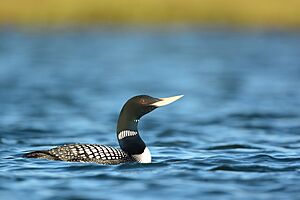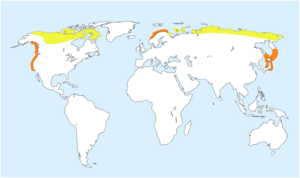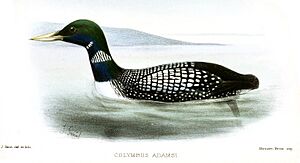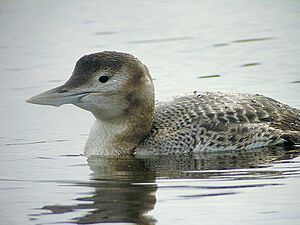Yellow-billed loon facts for kids
Quick facts for kids Yellow-billed loon |
|
|---|---|
 |
|
| Conservation status | |
| Scientific classification | |
| Genus: |
Gavia
|
| Species: |
adamsii
|
 |
|
| Range of G. adamsii Breeding range Wintering range | |
The yellow-billed loon (Gavia adamsii), also called the white-billed diver, is the biggest bird in the loon family. These amazing birds are known for their strong diving skills. They can catch fish deep underwater!
Adult yellow-billed loons have a black head and white belly. Their back has a cool black-and-white checkerboard pattern. When they are not breeding, their feathers look a bit duller. The easiest way to spot them is their long, straw-yellow beak. It looks a little bit tilted upwards.
Yellow-billed loons live and raise their young in the Arctic. When winter comes, they fly to the northern Pacific Ocean and northwestern Norway. They often spend winter along the coast or on big lakes. Sometimes, they travel far south, even appearing in countries like Mexico or Spain! Their call is a spooky, wailing sound, deeper than other loons.
Contents
What is a Yellow-Billed Loon?
The yellow-billed loon was first described in 1859 by an English scientist named George Robert Gray. He studied a bird found in Alaska. This loon is a single species, meaning it doesn't have different types, even though it lives in many places around the world.
It is very similar to the common loon in how it looks and acts. Some scientists even think they might be very close relatives. The name Gavia comes from a Latin word for "sea mew," used by an ancient Roman writer. The second part of its name, adamsii, honors Edward Adams, a British naval doctor and naturalist. He drew and collected many animals, including this loon, during his trips to the Arctic.
The word "loon" might come from old Norse or Dutch words meaning "clumsy." This probably refers to how hard it is for loons to walk on land. The name "diver" describes how they hunt underwater. "Yellow-billed" and "white-billed" simply describe their pale, unique beak.
How to Identify a Yellow-Billed Loon
The yellow-billed loon is the largest bird in the loon family. It can be about 76 to 97 centimeters (30 to 38 inches) long. Its wings can spread out from 135 to 160 centimeters (53 to 63 inches). These birds weigh between 4 and 6.4 kilograms (9 to 14 pounds).
When they are breeding, adult loons are mostly black and white. Their head and neck have a shiny purple color.
Where Do Yellow-Billed Loons Live?
The yellow-billed loon is an Arctic bird. It breeds mostly along the coasts of the Arctic Ocean, as far north as 78° N. In winter, it moves to the calm coastal waters of the northern Pacific Ocean and the northwestern coast of Norway.
You can find them breeding in Russia, Canada, and the United States. While they usually winter north of 50° N, their winter range can go as far south as 35° N near Japan. They have even been seen by chance in over 20 countries, including places like Mexico and Spain.
Life Cycle and Behavior
Reproduction
Yellow-billed loons form pairs that stay together for a long time. They prefer to build their nests near freshwater ponds or lakes in the tundra. However, they can also nest along rivers, estuaries, or the coast in flat Arctic areas. They usually avoid forests.
Breeding starts in early June, depending on when the ice melts. Like all loons, they build a nest from plants very close to the water's edge. The female lays two eggs. The eggs are about 89 by 55 millimeters (3.5 by 2.2 inches). They are oval-shaped and a light purple-brown with darker spots. This color helps them blend in with the soil and plants around the nest. The parents take turns sitting on the eggs for about 27 to 29 days until they hatch.
Feeding Habits
The yellow-billed loon mainly eats fish. But it also eats crustaceans (like crabs), molluscs (like snails), and annelids (like worms), especially for its young. It dives underwater to chase and catch its food. To stay healthy and avoid spreading parasites, they often go ashore to poop near their breeding lake.
Protecting Yellow-Billed Loons
In 2010, the International Union for the Conservation of Nature (IUCN) changed the yellow-billed loon's status. It went from "Least Concern" to "Near Threatened." This means their numbers seem to be going down "moderately fast." One main reason for this decline is too much hunting by indigenous peoples.
The yellow-billed loon is also protected by international agreements. These include the Agreement on the Conservation of African-Eurasian Migratory Waterbirds (AEWA) and, in the Americas, the Migratory Bird Treaty Act of 1918.
These loons are very sensitive because they don't have many babies. They face many dangers related to their homes. They need large, deep lakes, but these places are threatened by human activities like oil drilling. The warming climate also causes problems. Loons might leave their nests to find cooler areas, leaving their eggs and young unprotected from predators. They are also very protective of their territory. This can lead to fights with other birds that sometimes cause serious injuries or even death.




